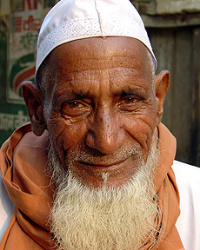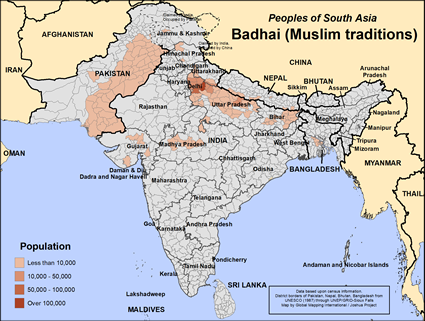Badhai (Muslim traditions) in Nepal

Photo Source:
Copyrighted © 2026
Anonymous All rights reserved. Used with permission |

Map Source:
People Group Location: Omid. Other geography / data: GMI. Map Design: Joshua Project
|
| People Name: | Badhai (Muslim traditions) |
| Country: | Nepal |
| 10/40 Window: | Yes |
| Population: | 2,400 |
| World Population: | 695,900 |
| Primary Language: | Urdu |
| Primary Religion: | Islam |
| Christian Adherents: | 0.00 % |
| Evangelicals: | 0.00 % |
| Scripture: | Complete Bible |
| Ministry Resources: | Yes |
| Jesus Film: | Yes |
| Audio Recordings: | Yes |
| People Cluster: | South Asia Hindu - Badhai |
| Affinity Bloc: | South Asian Peoples |
| Progress Level: |
|
Introduction / History
The Badhai name comes from the Sanskrit vardhna which means “cutting.” The Hindu community of the Badhai believe that their name comes from Vishvakarma, the Hindu god said to be the architect of the universe. Vishvakarma was said to have created two people groups: the cutters of wood, or Badhai people, and the workers of iron, or Lohar people. Most of those Badhai Muslims live in Uttar Pradesh but others are scattered through north India, Nepal, Bangladesh and Pakistan. The small Badhai population in Nepal is found mainly in Rapti, Bheri and Sagarmatha Zones. They primarily speak Nepali but also use Urdu, Bhojpuri and Maithili.
What Are Their Lives Like?
As mentioned above, the Badhai are traditionally wood-cutters and carpenters. While carpentry is still common today, some have acquired land and are involved in agriculture. The men have a custom of wearing the dhoti, a baniyan shirt and a red cloth, or gamcha, over the shoulder. They are not vegetarian and prefer rice and wheat as staple grains.
What Are Their Beliefs?
Though most Badhai are Hindus, the Badhai Muslims in Nepal Sunni Muslims. Sunni Muslims claim Allah is the one supreme God, who spoke through his prophet, Mohammed, and taught mankind how to live a righteous life through the Koran and the Hadith. To live a righteous life, you must utter the Shahada (a statement of faith), pray five times a day facing Mecca, fast from sunup to sundown during the month of Ramadan, give alms to the poor and make a pilgrimage to Mecca if you have the means. Muslims are prohibited from drinking alcohol, eating pork, gambling, stealing, slandering and making idols. They gather for corporate prayer on Friday afternoons at mosques, their places of worship.
The two main holidays for Sunni Muslims are Eid al Fitr, the breaking of the monthly fast and
Eid al Adha, the celebration of Abraham's willingness to sacrifice his son. In most of the Muslim world, people depend on the spirit world for their daily needs since they regard Allah as too distant. Allah may determine their eternal salvation, but the spirits determine the quality of their daily lives. For that reason, they must appease the spirits. They often use charms and amulets to appease spiritual forces.
What Are Their Needs?
There are currently no known believers among this group. They desperately need people to share the gospel with them so that they might be forgiven and reconciled to God. May woodworking Christians and other believers gain a burden for this group of people
Prayer Points
Pray for the Lord to send Christians to the Badhai people who will share the gospel with them.
Pray the Lord will grant repentance and faith to the Badhai people, even using dreams to draw them to himself.
Pray new believers would faithfully follow Christ, no matter the cost.
Pray God would provide new believers with courage to make disciples of those around them.